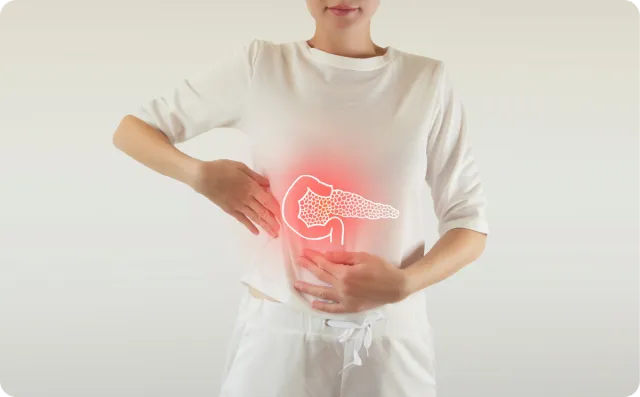
Jump to
Book a visit
$25 typical copay
$150 without insurance
Get fast relief for vomiting with a virtual GI consultation.
A virtual GI consultation allows you to discuss vomiting symptoms, including unusual colors and blood, with an expert who can provide insights and treatment options.
Key takeaways:
- Brown vomit may be caused by a variety of conditions that range in severity from mildly concerning to life-threatening.
- Informing your healthcare provider of any accompanying symptoms or medical history can help narrow the diagnosis.
- Brown vomit should never be ignored! Always consult a healthcare provider if you are experiencing this symptom.
Having episodes of brown vomiting can be scary for anyone. Whether its cause is harmless or a symptom of a serious health issue, it’s important to understand the meaning behind it. In this article, we discuss what brown vomit or bile means, its common causes, and when to seek medical attention.
What is brown-colored vomit or bile?
First, the difference between vomit and bile (although the terms are often used interchangeably). Bile is digestive fluid that’s produced by the liver and is stored in the gallbladder. Vomit is the contents of your stomach – partially digested food and liquid – that you expel when you throw up. Vomit may or may not contain bile.
When vomit is brown, it’s often because it contains digested (or partially digested) blood. In that case, it is likely a symptom of bleeding in the upper gastrointestinal (GI) tract, which consists of the esophagus, stomach, and part of the small intestine. Yet brown vomit can also arise from less severe factors such as dietary choices or bleeding from the mouth or sinuses.
When brown vomit or bile may be serious
The most serious cause of brown vomit is digested blood in the stomach from upper GI bleeding.
Upper GI bleeding may be chronic, meaning its symptoms come and go. Or it may be acute, which means it begins suddenly – and poses the greatest risk. Acute GI bleeding can have symptoms such as fatigue, weakness, and shortness of breath. If not caught and treated quickly, GI bleeding has the potential to become fatal.
Common causes of brown vomit or bile
As mentioned, a variety of factors can contribute to brown-colored vomit. Be sure to let your doctor know of any additional symptoms, underlying health conditions, or current medications you’re taking. This information can help narrow down the cause behind your brown vomit.
Gastrointestinal bleeding
The most common cause of upper GI bleeding is peptic ulcer disease, in which open sores develop in the stomach lining.
Peptic ulcers may be caused by regular use of nonsteroidal anti-inflammatory drugs (NSAIDs) such as ibuprofen, or by infection with Helicobacter pylori (H. pylori) bacteria. Aside from peptic ulcers, GI bleeding can also be caused by inflammation in the stomach or esophagus.
Bile reflux
Bile reflux occurs when a stomach valve is too relaxed, which allows bile to flow backward into the stomach.
In some cases, bile may flow into the esophagus and cause nausea and vomiting. The vomit can range in color from greenish-yellow to brown. Common causes of bile reflux are gastric bypass surgery and gallbladder removal surgery, as well as peptic ulcers. While it requires treatment to avoid complications, bile reflux is not considered a medical emergency.
Infection
The same bacterium (H. pylori) that causes peptic ulcer disease can also cause upper GI bleeding. Vomit will be brown and have a consistency similar to coffee grounds.
Repetitive vomiting due to GI infections can cause small tears in the esophagus and lead to the presence of blood in the vomit. While internal bleeding due to ulcers is an urgent medical issue that merits immediate treatment, micro-tears from repetitive vomiting are likely to clear up on their own.
Liver disease
Two types of liver disease are hepatitis, which is a general term for liver inflammation; and cirrhosis, in which the liver is gradually replaced by scar tissue.
Both of these diseases can involve GI bleeding. Liver disease may also impact bile production and lead to bile reflux. Bile reflux and GI bleeding are two potential causes of brown-colored vomit.
Common causes of brown vomit or bile based on appearance or another symptom
The appearance of brown vomit can vary in shade, composition, and texture. These subtle differences can help your doctor narrow down the potential cause behind it.
Brown vomit with a texture like coffee grounds
Coagulation (clotting of blood) can result in vomit that resembles coffee grounds and is caused by bleeding in the upper GI tract.
Causes of upper GI bleeds include ulcers, cancer of the stomach or esophagus, and inflammation. The color of the vomit may vary from red to dark brown or black depending on how old the blood is. The vomit’s coffee ground appearance is never a normal finding and should be treated as a medical emergency.
Light brown vomit or bile
Regardless of how light or dark vomit appears to be, any shade of brown should be taken seriously – because it could be a sign of internal bleeding.
Dark brown vomit or bile
Dark brown vomit or bile is typically an indication of digested blood in the vomit. It is likely to be a delayed sign of upper GI bleeding. Thus, it should be addressed immediately to prevent further bleeding or other complications.
Brown, liquid vomit or bile
Liquid vomit or bile is common when you've vomited repeatedly and have nothing left in your stomach. The liquid is likely bile and stomach acids. Still, if it is brown-colored, it is likely an indication of blood in the vomit.
Brown vomit or bile with blood
As mentioned, brown-colored vomit is usually a sign of internal bleeding. When there is bright-red blood, it is a sign of active bleeding and should be considered an urgent medical issue.
Although red blood in vomit may be from a less severe cause (such as swallowing blood from a nosebleed or mouth bleed), it’s best to be cautious and see a doctor.
Vomiting brown mucus
Mucus in the vomit is likely due to swallowed mucus from the nasal tract. This can happen because of a bad cold or a sinus infection.
In cases where the sinus tract is dry and irritated, there may be small amounts of blood that can give the mucus a brown appearance. Be sure to let your doctor know of any additional symptoms such as sinus congestion or pressure.
Brown specks or spots in vomit
Brown specks or spots in vomit should not be confused with vomit that resembles coffee grounds.
Whereas coffee-ground vomit is a serious medical emergency, specks or spots in vomit may be nothing more than partially digested food particles. Or, the specks or spots could be caused by bleeding from the gums, mouth, or throat.
Brown vomit along with diarrhea
If you’re suffering from a combination of brown vomit and diarrhea, you likely have viral gastroenteritis. – better known as the “stomach flu.” This condition typically involves repeated vomiting, which can cause brown vomit.
Symptoms can range from mild to severe, and you’ll typically recover within a few days on your own. See your doctor, however, if you’re unable to keep liquids down for more than 24 hours, have noticeable blood in your vomit or stool, have a lingering fever, or are experiencing weakness.
Brown vomit with an empty stomach
Even when your stomach is empty, brown-colored vomit may indicate digested blood from internal bleeding. Other causes of brown vomit with an empty stomach may be more benign, such as bile and/or stomach acids in the vomit.
Brown vomit while pregnant
As with other conditions mentioned, brown-colored vomit during pregnancy may be a sign of digested blood in the vomit. This is not normal and should be treated as a medical emergency. A quick response is essential to avoid potential harm to the mother and the fetus.
Brown vomit after drinking alcohol
Having a few drinks won’t necessarily cause you to vomit. But problem drinking, known as alcohol use disorder, can lead to complications such as alcohol-induced hepatitis, alcohol-induced cirrhosis, and peptic ulcer disease. All these conditions may cause brown vomit due to blood or bile in the vomit.
Brown vomit after drinking coffee
Research has shown no association between drinking coffee and the development of stomach ulcers and subsequent internal bleeding.
Thus, it’s unlikely that coffee consumption alone will cause gastrointestinal bleeding leading to brown vomit. If you experience brown vomit after drinking coffee, it may be due to bile or discoloration from the coffee itself. This is not considered a medical emergency. If it continues, however, don’t hesitate to consult with your doctor.
Read our guides on different types of vomit and its colors for more.
Diagnosing the causes of brown vomit or bile
Finding the cause of brown vomit typically involves a comprehensive physical evaluation. Here is what you can expect during your workup:
- Thorough history-taking. Your healthcare provider will ask about any other symptoms you’re experiencing, as well as your dietary habits, any medications you’re taking, and your general health history. You’ll also be asked about prior abdominal surgeries and your family history.
- Comprehensive physical examination. The physical exam will focus on the abdomen; specifically, any areas of tenderness or masses. Your doctor will also look for signs of underlying liver disease that may be linked to the presence of bile in the vomit. Vital signs will also be taken as significant blood loss can lead to changes in blood pressure and heart rate.
- Laboratory tests. Blood tests can check for signs of anemia (not enough healthy red blood cells). A blood test can also show iron deficiency due to blood loss, infection, dehydration, and liver abnormalities.
- Endoscopy. Your healthcare provider may refer you to have an endoscopy performed. This test is considered the gold standard for diagnosing and identifying the cause of upper GI bleeds. It can also identify many other potential abnormalities in the upper gastrointestinal tract.
- Imaging. You may also be referred for imaging studies such as a CT scan, which can locate the source of any upper GI bleeding.
Common treatment options for brown vomit or bile
The type of treatment you’ll receive for brown vomit will vary depending on the underlying cause. Following are some of the most common recommendations.
Medication
Medications that block or reduce acid production can help if the underlying cause is an ulcer or bile from GI reflux disease.
If the ulcer is caused by an H. pylori infection, you may be prescribed a combination of acid-reducing medications and antibiotics. You may also receive a prescription for anti-nausea drugs to stop the vomiting. Please let your doctor know what medications you are already taking and if you are pregnant, breastfeeding, or allergic to any medications.
Hydration
Two major concerns associated with brown vomit are dehydration from fluid loss and unstable blood pressure from blood loss. You may receive intravenous fluids to keep your blood pressure and hydration status under control.
Medical procedures
If the underlying cause of brown vomit is a GI bleed, your doctor may recommend several different procedures. Endoscopy is the least invasive option used to attempt to find and stop a bleed. If endoscopy is unsuccessful, surgical procedures may be warranted.
Questions to ask your doctor about brown vomit or bile
- What do you think is causing this brown vomit?
- What tests do you recommend, and what do they involve?
- What treatment options are available for this problem?
- What should I look for that would indicate an emergency?
Frequently asked questions: brown vomit or bile
Although brown vomit is not considered normal, it isn’t uncommon. In fact, healthcare providers encounter it rather frequently. Here are answers to some of the most common questions about brown-colored vomit.
What can I eat or drink after throwing up brown vomit or bile?
In general, it’s best to limit your diet to clear fluids (such as water or broth) when you’ve been vomiting.
You can gradually resume eating solid food when you can tolerate it. Other dietary recommendations may vary based on the underlying cause. If the brown vomit is due to a peptic ulcer, for instance, your doctor may advise you to avoid spicy or acidic foods, as well as drinks such as coffee, soda, or alcohol.
Read our guide on what to eat or drink after vomiting for more.
Is brown vomit a sign of food poisoning?
Not necessarily. Your healthcare provider will ask you questions about your diet, as well as other symptoms you’re having, such as abdominal pain or diarrhea. These kinds of questions will help pinpoint whether you have food poisoning or if there is another potential cause for your brown vomit.
A perplexing health issue
Vomiting is unpleasant enough – seeing that it’s brown can be alarming, although it isn’t always an emergency. Brown vomit can stem from a range of conditions, some of which are minor and some of which may require immediate attention. Knowing the potential causes and recognizing the severity of your symptoms will help you recognize when to seek medical advice.
General Medicine follows a strict editorial process, including using real experts to write our articles, vetted primary sources, fact-checking, a secondary medical review, and updates as necessary. This article was medically reviewed and fact checked by Dr. Pallabi Sanyal-Dey, MD.
Sources
Antunes, Catiele, et al., “Upper Gastrointestinal Bleeding,” StatPearls, StatPearls Publishing, August 17, 2024. https://pubmed.ncbi.nlm.nih.gov/29262121.
Bernal, William, and Julia Wendon, “Acute Liver Failure,” New England Journal of Medicine, Vol. 369,26 (2013): 2525–34. doi:10.1056/NEJMra1208937. https://pubmed.ncbi.nlm.nih.gov/24369077.
National Library of Medicine, “Alcohol Use Disorder (AUD),” Medline Plus, 2019. medlineplus.gov/alcoholusedisorderaud.html.
Shi, Xiaolan et al., “Bile Reflux Gastritis: Insights into Pathogenesis, Relevant Factors, Carcinomatous Risk, Diagnosis, and Management,” Gastroenterology Research and Practice, Vol. 2022 2642551. September 12, 2022. doi:10.1155/2022/2642551. www.ncbi.nlm.nih.gov/pmc/articles/PMC9484982.
Shimamoto, Takeshi et al., “No Association of Coffee Consumption with Gastric Ulcer, Duodenal Ulcer, Reflux Esophagitis, and Non-Erosive Reflux Disease: a Cross-Sectional Study of 8,013 Healthy Subjects in Japan,” PLOS One Vol. 8,6 e65996. June 12, 2013, doi:10.1371/journal.pone.0065996. www.ncbi.nlm.nih.gov/pmc/articles/PMC3680393.
Upchurch, Bennie, “Upper Gastrointestinal Bleeding (UGIB): Practice Essentials, Background, Etiology.” Medscape, October 19, 2019. emedicine.medscape.com/article/187857-overview.
Our editorial standards
At General Medicine, we cut through the clutter to make health care clearer, faster, and easier to navigate. Every article is grounded in evidence-based research and peer-reviewed journals, reviewed by medical professionals, and written in accessible language that helps you make health decisions with confidence. We’re committed to ensuring the quality and trustworthiness of our content and editorial process by providing information that is up-to-date, accurate, and actually useful. For more details on our editorial process, see here.



